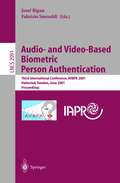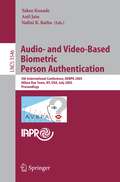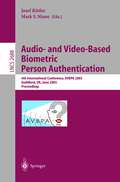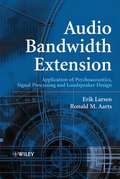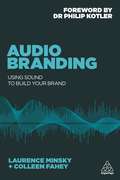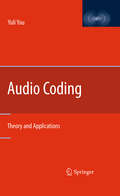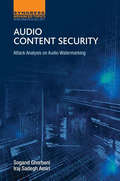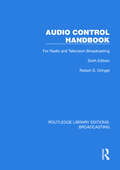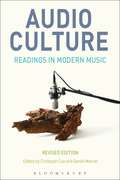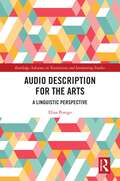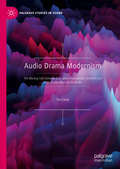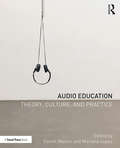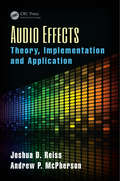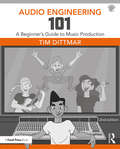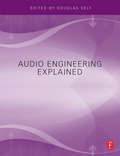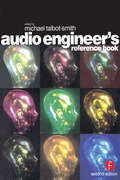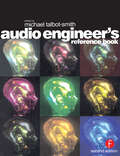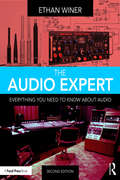- Table View
- List View
Audio- and Video-Based Biometric Person Authentication: Third International Conference, AVBPA 2001 Halmstad, Sweden, June 6-8, 2001. Proceedings (Lecture Notes in Computer Science #2091)
by Josef Bigun Fabrizio SmeraldiAudio- and Video-Based Biometric Person Authentication: 5th International Conference, AVBPA 2005, Hilton Rye Town, NY, USA, July 20-22, 2005, Proceedings (Lecture Notes in Computer Science #3546)
by Takeo Kanade Anil Jain Nalini K. RathaThis book constitutes the refereed proceedings of the 5th International Conference on Audio- and Video-Based Biometric Person Authentication, AVBPA 2005, held in Hilton Rye Town, NY, USA, in July 2005. The 66 revised oral papers and 50 revised poster papers presented were carefully reviewed and selected from numerous submissions. The papers discuss all aspects of biometrics including iris, fingerprint, face, palm print, gait, gesture, speaker, and signature; theoretical and algorithmic issues are dealt with as well as systems issues. The industrial side of biometrics is evident from presentations on smart cards, wireless devices, and architectural and implementation aspects.
Audio-and Video-Based Biometric Person Authentication: 4th International Conference, AVBPA 2003, Guildford, UK, June 9-11, 2003, Proceedings (Lecture Notes in Computer Science #2688)
by Josef Kittler Mark S. NixonThe refereed proceedings of the 4th International Conference on Audio-and Video-Based Biometric Person Authentication, AVBPA 2003, held in Guildford, UK, in June 2003. The 39 revised full plenary papers and 72 revised full poster papers were carefully reviewed and selected for presentation. There are topical sections on face; speech; fingerprint; image, video processing, and tracking; general issues; handwriting, signature, and palm; gait; and fusion.
Audio Bandwidth Extension: Application of Psychoacoustics, Signal Processing and Loudspeaker Design
by Erik Larsen Ronald M. AartsBandwidth extension (BWE) refers to various methods that increase either the perceived or real frequency spectrum (bandwidth) of audio signals. Such frequency extension is desirable if at some point the frequency content of the audio signal has been reduced, as can happen for example during recording, transmission or reproduction. This volume, significant in dealing exclusively with BWE, discusses applications to music and speech and places particular emphasis on signal processing techniques. Presents an all-encompassing approach to BWE by covering theory, applications and algorithms Reviews important concepts in psychoacoustics, signal processing and loudspeaker theory Develops the theory and implementation of BWE applied to low-frequency sound reproduction, perceptually coded audio, speech and noise abatement Includes a BWE patent overview Audio Bandwidth Extension pulls together recent developments in to a single volume and presents a coherent framework to the reader. Such an approach will have instant appeal to engineers, specialists, researchers and postgraduate students in the fields of audio, signal processing and speech.
Audio Branding: Using Sound to Build Your Brand
by Laurence Minsky Colleen FaheyAudio Branding is a concise, practical guide on the influential world of audio branding - what it is, why it's important, and how it can be used to enhance a brand. Consider the familiar tune of a branded ringtone, the bubbly sounds of Skype, and even the chosen sound bite for a branded car unlocking as the driver presses the key. How do these choices tie into a wider brand identity? Which emotions do they spark, and most importantly, how do these choices enhance brand association with the consumer?Audio Branding delivers fascinating insights into this area of marketing, underpinned by practical step-by-step guidance and cutting-edge research to enhance brand loyalty through user experience. Written by authors who have contributed directly to the development of this field, the book contains an enlightening set of case studies, including companies such as Renault (a surprisingly emotional audio brand) Atlanta Convention & Visitors Bureau (a warm, energetic audio brand), and Michelin (a globally coherent audio brand). Covering issues such as the dominance of audio-enabled devices and the phenomenon of continuous partial attention, Audio Branding demonstrates how brands can infuse sound into so many different aspects of their identity, building in a subtle longevity of brand presence through daily user experience.
Audio Branding: Using Sound to Build Your Brand
by Laurence Minsky Colleen FaheyAudio Branding is a concise, practical guide on the influential world of audio branding - what it is, why it's important, and how it can be used to enhance a brand. Consider the familiar tune of a branded ringtone, the bubbly sounds of Skype, and even the chosen sound bite for a branded car unlocking as the driver presses the key. How do these choices tie into a wider brand identity? Which emotions do they spark, and most importantly, how do these choices enhance brand association with the consumer?Audio Branding delivers fascinating insights into this area of marketing, underpinned by practical step-by-step guidance and cutting-edge research to enhance brand loyalty through user experience. Written by authors who have contributed directly to the development of this field, the book contains an enlightening set of case studies, including companies such as Renault (a surprisingly emotional audio brand) Atlanta Convention & Visitors Bureau (a warm, energetic audio brand), and Michelin (a globally coherent audio brand). Covering issues such as the dominance of audio-enabled devices and the phenomenon of continuous partial attention, Audio Branding demonstrates how brands can infuse sound into so many different aspects of their identity, building in a subtle longevity of brand presence through daily user experience.
Audio Coding: Theory and Applications
by Yuli YouAudio Coding: Theory and Applications provides succinct coverage of audio coding technologies that are widely used in modern audio coding standards. Delivered from the perspective of an engineer, this book articulates how signal processing is used in the context of audio coding. It presents a detailed treatment of contemporary audio coding technologies and then uses the DRA audio coding standard as a practical example to illustrate how numerous technologies are integrated into a fully-fledged audio coding algorithm. Drawing upon years of practical experience and using numerous examples and illustrations Dr. Yuli You, gives a description of practical audio coding technologies including: • Designing high-performance algorithms that can be readily implemented on fixed-point or integer microprocessors. • How to properly implement an audio decoder on various microprocessors. Transient detection and adaptation of time-frequency resolution of subband filters. • Psychoacoustic models and optimal bit allocation. Audio Coding: Theory and Applications will be a valuable reference book for engineers in the consumer electronics industry, as well as students and researchers in electrical engineering.
Audio Content Security: Attack Analysis on Audio Watermarking
by Iraj Sadegh Amiri Sogand GhorbaniAudio Content Security: Attack Analysis on Audio Watermarking describes research using a common audio watermarking method for four different genres of music, also providing the results of many test attacks to determine the robustness of the watermarking in the face of those attacks. The results of this study can be used for further studies and to establish the need to have a particular way of audio watermarking for each particular group of songs, each with different characteristics. An additional aspect of this study tests and analyzes two parameters of audio host file and watermark on a specific evaluation method (PSNR) for audio watermarking.Describes research using a common audio watermarking method for four different genres of musicProvides the results of many test attacksPresents tests and analyzes two parameters of audio host file and watermark on a specific evaluation method (PSNR) for audio watermarking
Audio Control Handbook: For Radio and Television Broadcasting (Routledge Library Editions: Broadcasting #3)
by Robert S. OringelAudio Control Handbook (1989) employs a step-by-step approach to prepare students for audio work in the broadcast industry, covering real-life principles, tools and procedures. It uses clear, nontechnical language to look at the effective use of standard audio equipment, from basic microphones and control boards to digital signal processors and tape recorders.
Audio Control Handbook: For Radio and Television Broadcasting (Routledge Library Editions: Broadcasting #3)
by Robert S. OringelAudio Control Handbook (1989) employs a step-by-step approach to prepare students for audio work in the broadcast industry, covering real-life principles, tools and procedures. It uses clear, nontechnical language to look at the effective use of standard audio equipment, from basic microphones and control boards to digital signal processors and tape recorders.
Audio Culture, Revised Edition: Readings in Modern Music
by Christoph Cox Daniel WarnerThe groundbreaking Audio Culture: Readings in Modern Music (Continuum; September 2004; paperback original) maps the aural and discursive terrain of vanguard music today. Rather than offering a history of contemporary music, Audio Culture traces the genealogy of current musical practices and theoretical concerns, drawing lines of connection between recent musical production and earlier moments of sonic experimentation. It aims to foreground the various rewirings of musical composition and performance that have taken place in the past few decades and to provide a critical and theoretical language for this new audio culture.This new and expanded edition of the Audio Culture contains twenty-five additional essays, including four newly-commissioned pieces. Taken as a whole, the book explores the interconnections among such forms as minimalism, indeterminacy, musique concrète, free improvisation, experimental music, avant-rock, dub reggae, ambient music, hip hop, and techno via writings by philosophers, cultural theorists, and composers. Instead of focusing on some "crossover" between "high art" and "popular culture," Audio Culture takes all these musics as experimental practices on par with, and linked to, one another. While cultural studies has tended to look at music (primarily popular music) from a sociological perspective, the concern here is philosophical, musical, and historical.Audio Culture includes writing by some of the most important musical thinkers of the past half-century, among them John Cage, Brian Eno, Ornette Coleman, Pauline Oliveros, Maryanne Amacher, Glenn Gould, Umberto Eco, Jacques Attali, Simon Reynolds, Eliane Radigue, David Toop, John Zorn, Karlheinz Stockhausen, and many others. Each essay has its own short introduction, helping the reader to place the essay within musical, historical, and conceptual contexts, and the volume concludes with a glossary, a timeline, and an extensive discography.
Audio Culture, Revised Edition: Readings in Modern Music
by Christoph Cox Daniel WarnerThe groundbreaking Audio Culture: Readings in Modern Music (Continuum; September 2004; paperback original) maps the aural and discursive terrain of vanguard music today. Rather than offering a history of contemporary music, Audio Culture traces the genealogy of current musical practices and theoretical concerns, drawing lines of connection between recent musical production and earlier moments of sonic experimentation. It aims to foreground the various rewirings of musical composition and performance that have taken place in the past few decades and to provide a critical and theoretical language for this new audio culture.This new and expanded edition of the Audio Culture contains twenty-five additional essays, including four newly-commissioned pieces. Taken as a whole, the book explores the interconnections among such forms as minimalism, indeterminacy, musique concrète, free improvisation, experimental music, avant-rock, dub reggae, ambient music, hip hop, and techno via writings by philosophers, cultural theorists, and composers. Instead of focusing on some "crossover" between "high art" and "popular culture," Audio Culture takes all these musics as experimental practices on par with, and linked to, one another. While cultural studies has tended to look at music (primarily popular music) from a sociological perspective, the concern here is philosophical, musical, and historical.Audio Culture includes writing by some of the most important musical thinkers of the past half-century, among them John Cage, Brian Eno, Ornette Coleman, Pauline Oliveros, Maryanne Amacher, Glenn Gould, Umberto Eco, Jacques Attali, Simon Reynolds, Eliane Radigue, David Toop, John Zorn, Karlheinz Stockhausen, and many others. Each essay has its own short introduction, helping the reader to place the essay within musical, historical, and conceptual contexts, and the volume concludes with a glossary, a timeline, and an extensive discography.
Audio Description for the Arts: A Linguistic Perspective (Routledge Advances in Translation and Interpreting Studies)
by Elisa PeregoThis book traces the development of audio description (AD), a form of audiovisual translation delivered orally and consumed aurally that makes visual elements accessible primarily to people who are visually impaired, and in particular, art AD as an emergent sub-genre. Perego reflects on the static arts and the role of modern museums as key sites for art AD and multisensory environments that create memorable experiences for visitors. Based on professional, pre-recorded British and American English AD scripts, this book outlines the textual and linguistic features of art AD and its most relevant textual patterns. It explores diverse AD practices across different contexts, including stand-alone ADs for specific paintings and sculptures that can be consumed independently to enhance the appeal and accessibility of cultural environments. Moreover, the book investigates AD tours, which provide descriptions of a selection of interconnected artworks while also assisting, through focused instructions, visually impaired individuals in navigating the museum space, as well as touch tours, which incorporate procedural instructions on how to experience three-dimensional art or reproductions through tactile senses. Offering unique insights and future research directions for this growing area, this volume will be of interest to students and scholars in translation studies and media accessibility.
Audio Description for the Arts: A Linguistic Perspective (Routledge Advances in Translation and Interpreting Studies)
by Elisa PeregoThis book traces the development of audio description (AD), a form of audiovisual translation delivered orally and consumed aurally that makes visual elements accessible primarily to people who are visually impaired, and in particular, art AD as an emergent sub-genre. Perego reflects on the static arts and the role of modern museums as key sites for art AD and multisensory environments that create memorable experiences for visitors. Based on professional, pre-recorded British and American English AD scripts, this book outlines the textual and linguistic features of art AD and its most relevant textual patterns. It explores diverse AD practices across different contexts, including stand-alone ADs for specific paintings and sculptures that can be consumed independently to enhance the appeal and accessibility of cultural environments. Moreover, the book investigates AD tours, which provide descriptions of a selection of interconnected artworks while also assisting, through focused instructions, visually impaired individuals in navigating the museum space, as well as touch tours, which incorporate procedural instructions on how to experience three-dimensional art or reproductions through tactile senses. Offering unique insights and future research directions for this growing area, this volume will be of interest to students and scholars in translation studies and media accessibility.
Audio Drama Modernism: The Missing Link between Descriptive Phonograph Sketches and Microphone Plays on the Radio (Palgrave Studies in Sound)
by Tim CrookAudio Drama and Modernism traces the development of political and modernist sound drama during the first 40 years of the 20th Century. It demonstrates how pioneers in the phonograph age made significant, innovative contributions to sound fiction before, during, and after the Great War. In stunning detail, Tim Crook examines prominent British modernist radio writers and auteurs, revealing how they negotiated their agitational contemporaneity against the forces of Institutional containment and dramatic censorship. The book tells the story of key figures such as Russell Hunting, who after being jailed for making ‘sound pornography’ in the USA, travelled to Britain to pioneer sound comedy and montage in the pre-Radio age; Reginald Berkeley who wrote the first full-length anti-war play for the BBC in 1925; and D.G. Bridson, Olive Shapley and Joan Littlewood who all struggled to give a Marxist voice to the working classes on British radio.
Audio Education: Theory, Culture, and Practice
by Daniel Walzer Mariana LopezAudio Education: Theory, Culture, and Practice is a groundbreaking volume of 16 chapters exploring the historical perspectives, methodologies, and theoretical underpinnings that shape audio in educational settings. Bringing together insights from a roster of international contributors, this book presents perspectives from researchers, practitioners, educators, and historians. Audio Education highlights a range of timely topics, including environmental sustainability, inclusivity, interaction with audio industries, critical listening, and student engagement, making it recommended reading for teachers, researchers, and practitioners engaging with the field of audio education.
Audio Education: Theory, Culture, and Practice
by Daniel Walzer Mariana LopezAudio Education: Theory, Culture, and Practice is a groundbreaking volume of 16 chapters exploring the historical perspectives, methodologies, and theoretical underpinnings that shape audio in educational settings. Bringing together insights from a roster of international contributors, this book presents perspectives from researchers, practitioners, educators, and historians. Audio Education highlights a range of timely topics, including environmental sustainability, inclusivity, interaction with audio industries, critical listening, and student engagement, making it recommended reading for teachers, researchers, and practitioners engaging with the field of audio education.
Audio Effects: Theory, Implementation and Application
by Joshua D. ReissAudio Effects: Theory, Implementation and Application explores digital audio effects relevant to audio signal processing and music informatics. It supplies fundamental background information on digital signal processing, focusing on audio-specific aspects that constitute the building block on which audio effects are developed. The text integrates t
Audio Engineering 101: A Beginner's Guide to Music Production
by Tim DittmarPratical, concise, and approachable, Audio Engineering 101, Second Edition covers everything aspiring audio engineers need to know to make it in the recording industry, from the characteristics of sound to microphones, analog versus digital recording, EQ/compression, mixing, mastering, and career skills. Filled with hand-on, step-by-step technique breakdowns and all-new interviews with active professionals, this updated edition includes instruction in using digital consoles, iPads for mixing, audio apps, plug-ins, home studios, and audio for podcasts. An extensive companion website features fifteen new video tutorials, audio clips, equipment lists, quizzes, and student exercises.
Audio Engineering 101: A Beginner's Guide to Music Production
by Tim DittmarPratical, concise, and approachable, Audio Engineering 101, Second Edition covers everything aspiring audio engineers need to know to make it in the recording industry, from the characteristics of sound to microphones, analog versus digital recording, EQ/compression, mixing, mastering, and career skills. Filled with hand-on, step-by-step technique breakdowns and all-new interviews with active professionals, this updated edition includes instruction in using digital consoles, iPads for mixing, audio apps, plug-ins, home studios, and audio for podcasts. An extensive companion website features fifteen new video tutorials, audio clips, equipment lists, quizzes, and student exercises.
Audio Engineering Explained
by Douglas SelfAll the design and development inspiration and direction an audio engineer needs in one blockbuster book! Douglas Self has selected the very best sound engineering design material from the Focal and Newnes portfolio and complied it into this volume. The result is a book covering the gamut of sound engineering.The material has been selected for its timelessness as well as for its relevance to contemporary sound engineering issues.
Audio Engineering Explained
by Douglas SelfAll the design and development inspiration and direction an audio engineer needs in one blockbuster book! Douglas Self has selected the very best sound engineering design material from the Focal and Newnes portfolio and complied it into this volume. The result is a book covering the gamut of sound engineering.The material has been selected for its timelessness as well as for its relevance to contemporary sound engineering issues.
Audio Engineer's Reference Book
by Michael Talbot-SmithAn authoritative reference on all aspects of audio engineering and technology including basic mathematics and formulae, acoustics and psychoacoustics, microphones, loudspeakers and studio installations. Compiled by an international team of experts, the second edition was updated to keep abreast of fast-moving areas such as digital audio and transmission technology. Much of the material has been revised, updated and expanded to cover the very latest techniques. This is a new paperback version.
Audio Engineer's Reference Book
by Michael Talbot-SmithAn authoritative reference on all aspects of audio engineering and technology including basic mathematics and formulae, acoustics and psychoacoustics, microphones, loudspeakers and studio installations. Compiled by an international team of experts, the second edition was updated to keep abreast of fast-moving areas such as digital audio and transmission technology. Much of the material has been revised, updated and expanded to cover the very latest techniques. This is a new paperback version.
The Audio Expert: Everything You Need to Know About Audio
by Ethan WinerThe Audio Expert is a comprehensive reference book covering all aspects of audio, with both practical and theoretical explanations. It is written for people who want to understand audio at the deepest, most technical level, but without needing an engineering degree. The Audio Expert explains how audio really works in much more depth than usual, using common sense plain-English explanations and mechanical analogies, with minimal math. It uses an easy to read conversational tone, and includes more than 400 figures and photos to augment the printed text. However, this book goes beyond merely explaining how audio works. It brings together the concepts of audio, aural perception, musical instrument physics, acoustics, and basic electronics, showing how they’re intimately related. It also describes in great detail many practices and techniques used by recording and mixing engineers, including video production and computers. This book is meant for intermediate to advanced recording engineers and audiophiles who want to become experts. There’s plenty for beginners too. One unique feature is explaining how audio devices such as equalizers, compressors, and A/D converters work internally, and how they’re spec’d and tested, rather than merely describing how to use them. There’s plenty of myth-busting and consumerism too. The book doesn’t tell readers what brand power amplifier to buy, but it explains in great detail what defines a good amplifier so people can choose a first-rate model wisely without over-paying. Most explanations throughout the book are platform-agnostic, applying equally to Windows and Mac computers, and to most software and hardware. Many audio and video examples are included to enhance the written text. The new edition offers many updates and improvements throughout. New sections on coding an equalizer, comparing microphone preamps, testing results of loudspeaker isolation devices, new online video content on music theory, plus incorporated chapters on MIDI basics, computers, video production, plus new myth-busters, and much more!
